Server FTP su STM32 con W5500, ENC28J60, scheda SD e memoria flash SPI
Infine, vado ad aggiornare il SimpleFTPServer con supporto completo e testato per i dispositivi STM32. Per i test, userò un dispositivo w5500 e un enc28j60. Per la memorizzazione, utilizzerò un semplice adattatore per schede SD e una memoria flash SPI esterna.
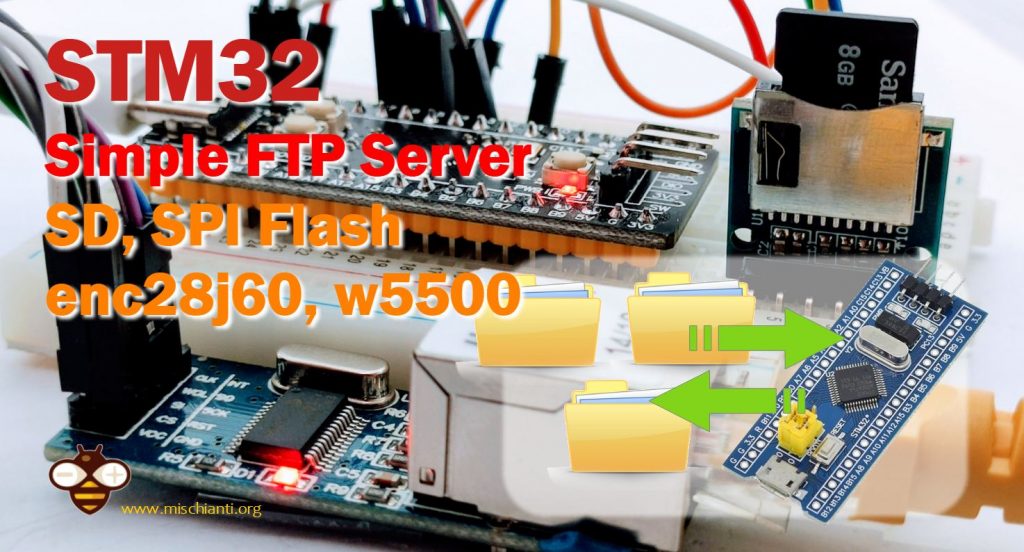
Puoi fare riferimento all’articolo “Come utilizzare la scheda SD con l’stm32 e la libreria SdFat” per il cablaggio e la configurazione della SD, all’articolo “STM32: memoria flash SPI FAT FS” per il Flash SPI, e agli articoli “STM32: ethernet w5500 standard (HTTP) e SSL (HTTPS)” e “STM32: ethernet enc28j60 standard (HTTP) e SSL (HTTPS)” per la configurazione dei dispositivi Ethernet.
Ecco una selezione di dispositivi STM32 STM32F103C8T6 STM32F401 STM32F411 ST-Link v2 ST-Link v2 official
Libreria
La libreria è disponibile direttamente dal gestore di librerie dell’IDE Arduino.

O il codice sorgente da GitHub.
Configurazione
Per STM32 ho già testato 2 tipi di rete, uno con w5500 e uno con enc28j60, e 2 soluzioni di memorizzazione, la SD e la SPIFlash esterna.
// STM32 configuration
#ifndef DEFAULT_FTP_SERVER_NETWORK_TYPE_STM32
#define DEFAULT_FTP_SERVER_NETWORK_TYPE_STM32 NETWORK_W5100
#define DEFAULT_STORAGE_TYPE_STM32 STORAGE_SDFAT2
#endif
Come puoi vedere, la configurazione predefinita richiede un adattatore Ethernet come w5500 (libreria Ethernet Arduino standard) e una SD gestita dalla libreria SdFat 2.x.
Ma puoi scegliere tra una vasta varietà di dispositivi di rete:
#define NETWORK_ESP8266_ASYNC (1)
#define NETWORK_ESP8266 (2) // Standard ESP8266WiFi
#define NETWORK_ESP8266_242 (3) // ESP8266WiFi before 2.4.2 core
#define NETWORK_W5100 (4) // Standard Arduino Ethernet library
#define NETWORK_ENC28J60 (5) // UIPEthernet library
#define NETWORK_ESP32 (6) // Standard WiFi library
#define NETWORK_ESP32_ETH (7) // Standard ETH library
#define NETWORK_WiFiNINA (8) // Standard WiFiNINA library
#define NETWORK_SEEED_RTL8720DN (9) // Standard SEED WiFi library
#define NETWORK_ETHERNET_LARGE (10)
#define NETWORK_ETHERNET_ENC (11) // EthernetENC library (evolution of UIPEthernet
#define NETWORK_ETHERNET_STM (12)
#define NETWORK_UIPETHERNET (13) // UIPEthernet library same of NETWORK_ENC28J60
In particolare, vedremo la NETWORK_W5100 e la NETWORK_ETHERNET_ENC che è un’evoluzione della libreria UIPEthernet.
Ecco i dispositivi di memorizzazione:
#define STORAGE_SDFAT1 1 // Library SdFat version 1.4.x
#define STORAGE_SDFAT2 2 // Library SdFat version >= 2.0.2
#define STORAGE_SPIFM 3 // Libraries Adafruit_SPIFlash and SdFat-Adafruit-Fork
#define STORAGE_FATFS 4 // Library FatFs
#define STORAGE_SD 5 // Standard SD library (suitable for Arduino esp8266 and esp32
#define STORAGE_SPIFFS 6 // SPIFFS
#define STORAGE_LITTLEFS 7 // LITTLEFS
#define STORAGE_SEEED_SD 8 // Seeed_SD library
#define STORAGE_FFAT 9 // ESP32 FFAT
Ho utilizzato e testato STORAGE_SDFAT2 per la SD e STORAGE_SPIFM per la flash SPI esterna.
Scheda SD ed ethernet w5500
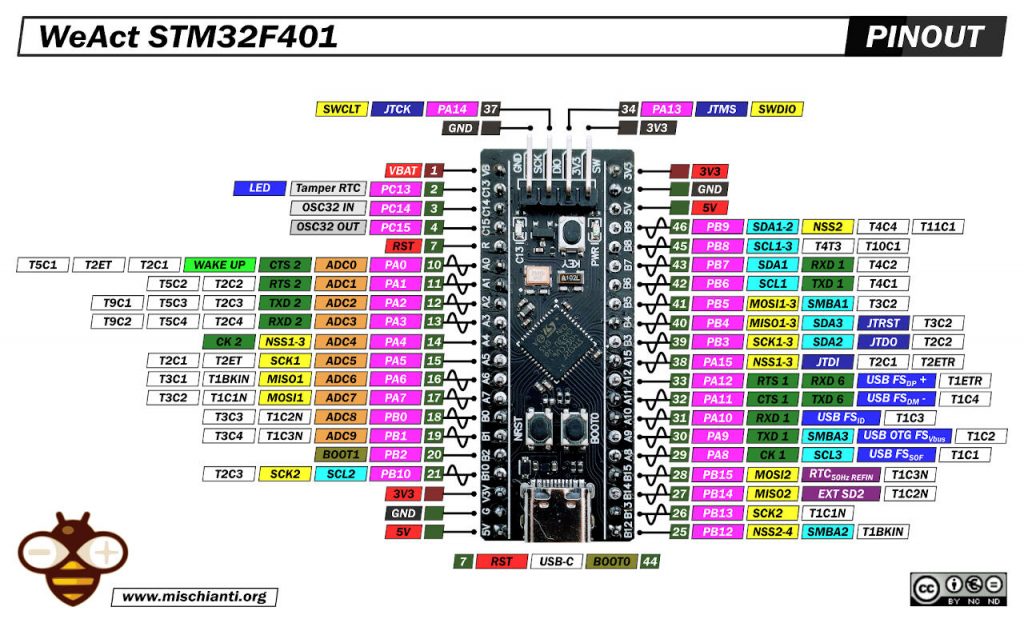
Ecco la mia selezione di dispositivi STM32 STM32F103C8T6 STM32F401 STM32F411 ST-Link v2 ST-Link v2 official
w5500 è uno dei dispositivi ethernet più efficienti, iniziamo con questo.
STM32F4 con w5500 e SD sull’interfaccia SPI secondaria
Questo è il primo esempio, penso che sia la situazione più comune con un controller ethernet w5500 sulla SPI primaria e la SD sull’interfaccia SPI secondaria dedicata.
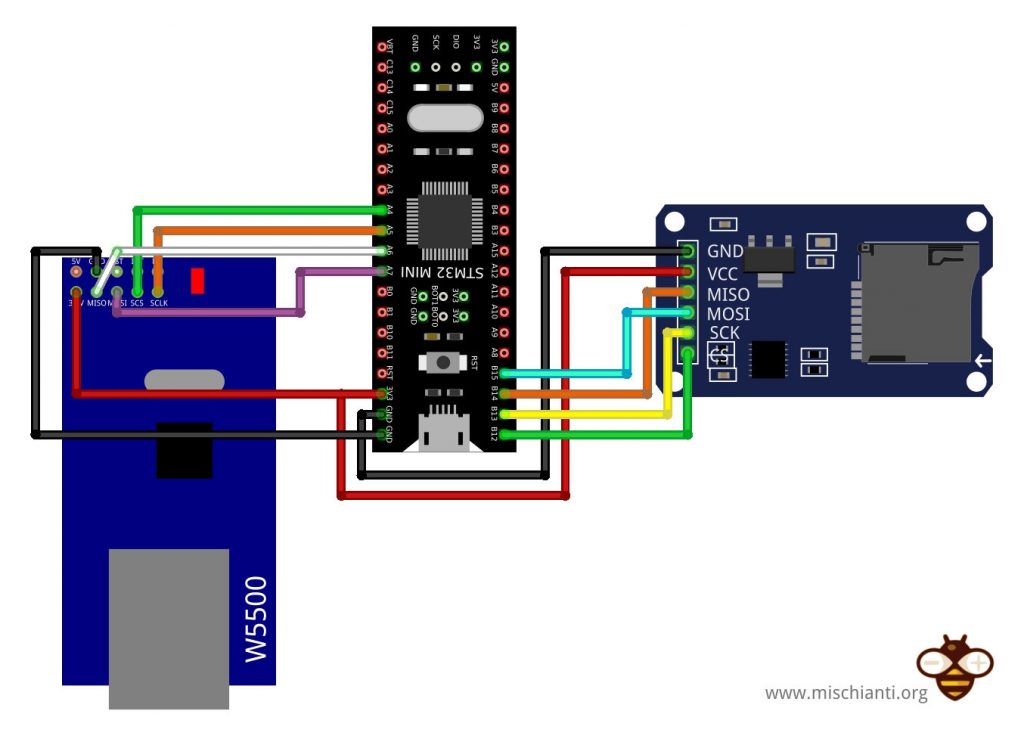
Ecco i miei dispositivi ethernet testati w5500 lite - w5500 - enc26j60 mini - enc26j60 - lan8720
| STM32 | w5500 SPI1 |
|---|---|
| PA4 | CS |
| PA5 | SCK |
| PA6 | MISO |
| PA7 | MOSI |
| 3.3v | 3.3v |
| GND | GND |
Adattatori per schede SD AliExpress
| STM32 | Scheda SD SPI2 |
|---|---|
| PA12 | CS |
| PA13 | SCK |
| PA14 | MISO |
| PA15 | MOSI |
| 3.3v | VCC |
| GND | GND |
Esempio di sketch
Creeremo un esempio primario con w5500 collegato all’interfaccia SPI primaria e SS standard, e la scheda SD sull’interfaccia SPI secondaria.
Configurazione SimpleFTPServer
Come descritto per la scheda SD utilizziamo la libreria SdFat 2.x e la libreria Ethernet Arduino standard per w5500.
#ifndef DEFAULT_FTP_SERVER_NETWORK_TYPE_STM32
#define DEFAULT_FTP_SERVER_NETWORK_TYPE_STM32 NETWORK_W5100
#define DEFAULT_STORAGE_TYPE_STM32 STORAGE_SDFAT2
#endif
Codice completo
/**
* SimpleFTPServer ^1.3.0 on STM32 (need FLASH > 64K)
* and ethernet w5500
* SD connected on secondary SPI or primary
*
#ifndef DEFAULT_FTP_SERVER_NETWORK_TYPE_STM32
#define DEFAULT_FTP_SERVER_NETWORK_TYPE_STM32 NETWORK_W5100
#define DEFAULT_STORAGE_TYPE_STM32 STORAGE_SDFAT2
#endif
*
* @author Renzo Mischianti <www.mischianti.org>
* @details www.mischianti.org
* @version 0.1
* @date 2022-03-22
*
* @copyright Copyright (c) 2022
*
*/
#include <SdFat.h>
#include <sdios.h>
#include <Ethernet.h>
#include <SimpleFtpServer.h>
// To use SD with primary SPI
// #define SD_CS_PIN PA4
// To use SD with secondary SPI
#define SD_CS_PIN PB12
static SPIClass mySPI2(PB15, PB14, PB13, SD_CS_PIN);
#define SD2_CONFIG SdSpiConfig(SD_CS_PIN, DEDICATED_SPI, SD_SCK_MHZ(18), &mySPI2)
SdFat sd;
FtpServer ftpSrv; //set #define FTP_DEBUG in ESP8266FtpServer.h to see ftp verbose on serial
// Enter a MAC address for your controller below.
// Newer Ethernet shields have a MAC address printed on a sticker on the shield
byte mac[] = { 0xDE, 0xAD, 0xBE, 0xEF, 0xFE, 0xED };
// Set the static IP address to use if the DHCP fails to assign
#define MYIPADDR 192,168,1,28
#define MYIPMASK 255,255,255,0
#define MYDNS 192,168,1,1
#define MYGW 192,168,1,1
// Initialize the Ethernet client library
// with the IP address and port of the server
// that you want to connect to (port 80 is default for HTTP):
EthernetClient client;
void setup() {
Serial.begin( 115200 );
while (!Serial) { delay(100); }
Serial.print("\nInitializing SD card...");
// Secondary SPI for SD
if (!sd.begin(SD2_CONFIG)) {
// Primary SPI for SD
// if (!SD.begin(SD_CS_PIN)) {
Serial.println(F("initialization failed. Things to check:"));
Serial.println(F("* is a card inserted?"));
Serial.println(F("* is your wiring correct?"));
Serial.println(F("* did you change the chipSelect pin to match your shield or module?"));
while (1);
} else {
Serial.println(F("Wiring is correct and a card is present."));
}
// Show capacity and free space of SD card
Serial.print(F("Capacity of card: ")); Serial.print(long( sd.card()->sectorCount() >> 1 )); Serial.println(F(" kBytes"));
// You can use Ethernet.init(pin) to configure the CS pin
Ethernet.init(PA4);
if (Ethernet.begin(mac)) { // Dynamic IP setup
Serial.println(F("DHCP OK!"));
}else{
Serial.println(F("Failed to configure Ethernet using DHCP"));
// Check for Ethernet hardware present
if (Ethernet.hardwareStatus() == EthernetNoHardware) {
Serial.println(F("Ethernet shield was not found. Sorry, can't run without hardware. :("));
while (true) {
delay(1); // do nothing, no point running without Ethernet hardware
}
}
if (Ethernet.linkStatus() == LinkOFF) {
Serial.println(F("Ethernet cable is not connected."));
}
IPAddress ip(MYIPADDR);
IPAddress dns(MYDNS);
IPAddress gw(MYGW);
IPAddress sn(MYIPMASK);
Ethernet.begin(mac, ip, dns, gw, sn);
Serial.println("STATIC OK!");
}
delay(5000);
Serial.print("Local IP : ");
Serial.println(Ethernet.localIP());
Serial.print("Subnet Mask : ");
Serial.println(Ethernet.subnetMask());
Serial.print("Gateway IP : ");
Serial.println(Ethernet.gatewayIP());
Serial.print("DNS Server : ");
Serial.println(Ethernet.dnsServerIP());
Serial.println("Ethernet Successfully Initialized");
Serial.println();
// Initialize the FTP server
ftpSrv.begin("user","password");
Serial.println("Ftp server started!");
}
void loop()
{
ftpSrv.handleFTP();
// more processes...
}
Puoi anche usare il login anonimo con
ftpSrv.begin();
Scheda SD ed ethernet enc28j60
Un altro dispositivo ethernet popolare è l’enc28j60, molto economico ma con alcuni limiti di memoria, comunque più che sufficiente per il nostro scopo.
STM32F4 con enc28j60 e SD sull’interfaccia SPI primaria
Un’altra situazione classica è l’uso di tutti i dispositivi sulla stessa interfaccia SPI con la selezione di CS. In questa configurazione, userai un numero limitato di pin: 5 per tutti i dispositivi.
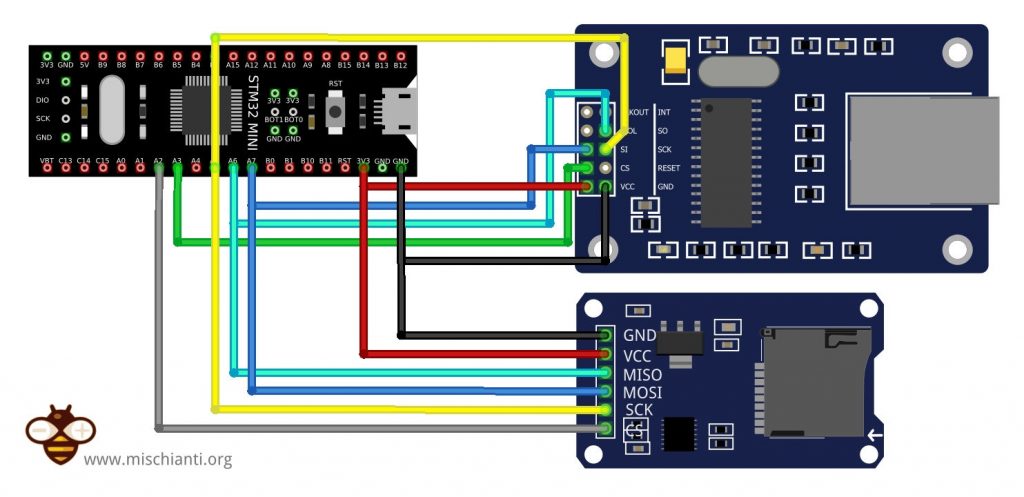
Ecco i miei dispositivi ethernet testati w5500 lite - w5500 - enc26j60 mini - enc26j60 - lan8720
Ecco il modulo SD che uso AliExpress
| STM32 | enc28j60 SPI1 |
|---|---|
| PA3 | CS |
| PA5 | SCK |
| PA6 | MISO |
| PA7 | MOSI |
| 3.3v | 3.3v |
| GND | GND |
Adattatori per schede SD AliExpress
| STM32 | Scheda SD SPI2 |
|---|---|
| PA2 | CS |
| PA5 | SCK |
| PA6 | MISO |
| PA7 | MOSI |
| 3.3v | VCC |
| GND | GND |
Esempio di sketch
Utilizzeremo enc28j60 e un adattatore per schede SD sul dispositivo SPI principale, cambiando il CS predefinito di Ethernet in PA2 e il CS della SD in PA3.
Configurazione di SimpleFTPServer
Per le schede SD utilizziamo la libreria SdFat 2.x e EthernetENC per enc28j60, un’evoluzione di UIPEthernet.
#ifndef DEFAULT_FTP_SERVER_NETWORK_TYPE_STM32
#define DEFAULT_FTP_SERVER_NETWORK_TYPE_STM32 NETWORK_ETHERNET_ENC
#define DEFAULT_STORAGE_TYPE_STM32 STORAGE_SDFAT2
#endif
Codice completo
/**
* SimpleFTPServer ^1.3.0 on STM32 (need FLASH > 64K)
* and ethernet enc28j60
* SD connected on secondary SPI or primary
*
#ifndef DEFAULT_FTP_SERVER_NETWORK_TYPE_STM32
#define DEFAULT_FTP_SERVER_NETWORK_TYPE_STM32 NETWORK_W5100
#define DEFAULT_STORAGE_TYPE_STM32 STORAGE_SDFAT2
#endif
*
* @author Renzo Mischianti <www.mischianti.org>
* @details www.mischianti.org
* @version 0.1
* @date 2022-03-22
*
* @copyright Copyright (c) 2022
*
*/
#include <SdFat.h>
#include <sdios.h>
#include <SimpleFtpServer.h>
#include <EthernetEnc.h>
// Ethernet CS
#define ETHERNET_CS_PIN PA3
// To use SD with primary SPI
#define SD_CS_PIN PA2
// To use SD with secondary SPI
// #define SD_CS_PIN PB12
// static SPIClass mySPI2(PB15, PB14, PB13, SD_CS_PIN);
// #define SD2_CONFIG SdSpiConfig(SD_CS_PIN, DEDICATED_SPI, SD_SCK_MHZ(18), &mySPI2)
SdFat sd;
FtpServer ftpSrv; //set #define FTP_DEBUG in ESP8266FtpServer.h to see ftp verbose on serial
// Enter a MAC address for your controller below.
// Newer Ethernet shields have a MAC address printed on a sticker on the shield
byte mac[] = { 0xDE, 0xAD, 0xBE, 0xEF, 0xFE, 0xED };
// Set the static IP address to use if the DHCP fails to assign
#define MYIPADDR 192,168,1,28
#define MYIPMASK 255,255,255,0
#define MYDNS 192,168,1,1
#define MYGW 192,168,1,1
// Initialize the Ethernet client library
// with the IP address and port of the server
// that you want to connect to (port 80 is default for HTTP):
EthernetClient client;
void setup() {
Serial.begin( 115200 );
while (!Serial) { delay(100); }
pinMode( SD_CS_PIN, OUTPUT );
digitalWrite( SD_CS_PIN, HIGH );
pinMode( ETHERNET_CS_PIN, OUTPUT );
digitalWrite( ETHERNET_CS_PIN, HIGH );
Serial.print("\nInitializing SD card...");
// To use SD with secondary SPI
// if (!sd.begin(SD2_CONFIG)) {
// To use SD with primary SPI
if (!sd.begin(SD_CS_PIN)) {
Serial.println(F("initialization failed. Things to check:"));
Serial.println(F("* is a card inserted?"));
Serial.println(F("* is your wiring correct?"));
Serial.println(F("* did you change the chipSelect pin to match your shield or module?"));
while (1);
} else {
Serial.println(F("Wiring is correct and a card is present."));
}
// Show capacity and free space of SD card
Serial.print(F("Capacity of card: ")); Serial.print(long( sd.card()->sectorCount() >> 1 )); Serial.println(F(" kBytes"));
// You can use Ethernet.init(pin) to configure the CS pin
Ethernet.init(ETHERNET_CS_PIN);
if (Ethernet.begin(mac)) { // Dynamic IP setup
Serial.println(F("DHCP OK!"));
}else{
Serial.println(F("Failed to configure Ethernet using DHCP"));
// Check for Ethernet hardware present
if (Ethernet.hardwareStatus() == EthernetNoHardware) {
Serial.println(F("Ethernet shield was not found. Sorry, can't run without hardware. :("));
while (true) {
delay(1); // do nothing, no point running without Ethernet hardware
}
}
if (Ethernet.linkStatus() == LinkOFF) {
Serial.println(F("Ethernet cable is not connected."));
}
IPAddress ip(MYIPADDR);
IPAddress dns(MYDNS);
IPAddress gw(MYGW);
IPAddress sn(MYIPMASK);
Ethernet.begin(mac, ip, dns, gw, sn);
Serial.println("STATIC OK!");
}
delay(5000);
Serial.print("Local IP : ");
Serial.println(Ethernet.localIP());
Serial.print("Subnet Mask : ");
Serial.println(Ethernet.subnetMask());
Serial.print("Gateway IP : ");
Serial.println(Ethernet.gatewayIP());
Serial.print("DNS Server : ");
Serial.println(Ethernet.dnsServerIP());
Serial.println("Ethernet Successfully Initialized");
Serial.println();
// Initialize the FTP server
ftpSrv.begin("user","password");
Serial.println("Ftp server started!");
}
void loop()
{
ftpSrv.handleFTP();
// more processes...
}
SPI Flash ed Ethernet w5500
Per questi test, puoi seguire l’articolo relativo alla Flash SPI “STM32: memoria flash SPI FAT FS”, e utilizziamo l’impronta integrata della Flash SPI della STM32F4 Black-pill.
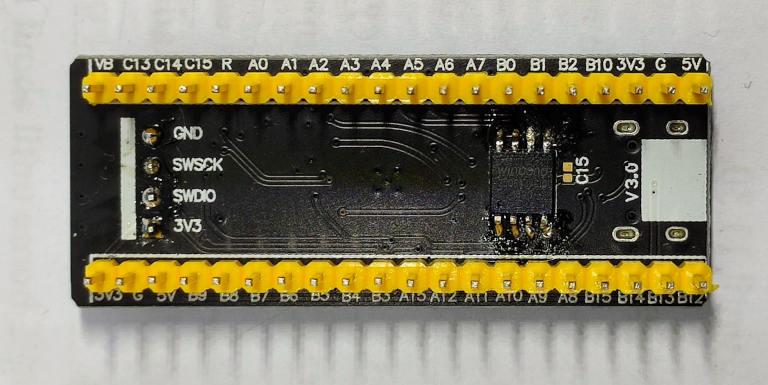
Ecco un set di Flash SPI testate w25q16 SMD 2Mb - w25q16 Discrete 2Mb - w25q32 SMD 4Mb - w25q32 Discrete 4Mb - w25q64 SMD 8Mb - w25q64 Discrete 8Mb - w25q128 SMD 16Mb - w25q128 Discrete 16Mb W25Q32 W25Q64 w25q128 module 4Mb 8Mb 16Mb
Cablaggio w5500
Ora usiamo solo l’Ethernet w5500 sul SPI principale, ma fai attenzione a non usare il pin PA4 come nello schema, perché è utilizzato dalla Flash SPI sull’impronta.

Ecco i miei dispositivi ethernet testati w5500 lite - w5500 - enc26j60 mini - enc26j60 - lan8720
| STM32 | w5500 SPI1 |
|---|---|
| PA3 | CS |
| PA5 | SCK |
| PA6 | MISO |
| PA7 | MOSI |
| 3.3v | 3.3v |
| GND | GND |
| STM32 | SPI Flash |
|---|---|
| PA4 | CS |
| PA5 | SCK |
| PA6 | MISO |
| PA7 | MOSI |
| 3.3v | VCC |
| GND | GND |
Esempio di sketch
Fai attenzione ai pin CS. PA4 per la Flash SPI e PA3 su Ethernet w5500.
Configurazione di SimpleFTPServer
Per la Flash SPI, come descritto nell’articolo relativo alla Flash SPI, utilizziamo la libreria Adafruit_SPIFlash e SdFat-Adafruit-Fork e la libreria Arduino Ethernet standard per w5500.
#ifndef DEFAULT_FTP_SERVER_NETWORK_TYPE_STM32
#define DEFAULT_FTP_SERVER_NETWORK_TYPE_STM32 NETWORK_W5100
#define DEFAULT_STORAGE_TYPE_STM32 STORAGE_SPIFM
#endif
Codice completo
/**
* SimpleFTPServer ^1.3.0 on STM32 (need FLASH > 64K)
* and ethernet w5500
* SPI Flash with Adafruit_SPIFlash and SdFat-Adafruit-Fork library
*
#ifndef DEFAULT_FTP_SERVER_NETWORK_TYPE_STM32
#define DEFAULT_FTP_SERVER_NETWORK_TYPE_STM32 NETWORK_W5100
#define DEFAULT_STORAGE_TYPE_STM32 STORAGE_SPIFM
#endif
*
* @author Renzo Mischianti <www.mischianti.org>
* @details www.mischianti.org
* @version 0.1
* @date 2022-03-22
*
* @copyright Copyright (c) 2022
*
*/
#include <Arduino.h>
#include <Ethernet.h>
#include "SdFat.h"
#include "Adafruit_SPIFlash.h"
#include <SimpleFTPServer.h>
Adafruit_FlashTransport_SPI flashTransport(SS, SPI); // Set CS and SPI interface
Adafruit_SPIFlash flash(&flashTransport);
// file system object from SdFat
FatFileSystem fatfs;
#define ETHERNET_CS_PIN PA3
FtpServer ftpSrv; //set #define FTP_DEBUG in ESP8266FtpServer.h to see ftp verbose on serial
// Enter a MAC address for your controller below.
// Newer Ethernet shields have a MAC address printed on a sticker on the shield
byte mac[] = { 0xDE, 0xAD, 0xBE, 0xEF, 0xFE, 0xED };
// Set the static IP address to use if the DHCP fails to assign
#define MYIPADDR 192,168,1,28
#define MYIPMASK 255,255,255,0
#define MYDNS 192,168,1,1
#define MYGW 192,168,1,1
// Initialize the Ethernet client library
// with the IP address and port of the server
// that you want to connect to (port 80 is default for HTTP):
EthernetClient client;
void setup() {
// Initialize serial port and wait for it to open before continuing.
Serial.begin(115200);
while (!Serial) {
delay(100);
}
Serial.println("Adafruit SPI Flash FatFs Full Usage Example");
// Initialize flash library and check its chip ID.
if (!flash.begin()) {
Serial.println("Error, failed to initialize flash chip!");
while(1) yield();
}
Serial.print("JEDEC ID: "); Serial.println(flash.getJEDECID(), HEX);
Serial.print("Flash size: "); Serial.println(flash.size());
Serial.flush();
// First call begin to mount the filesystem. Check that it returns true
// to make sure the filesystem was mounted.
if (!fatfs.begin(&flash)) {
Serial.println("Error, failed to mount newly formatted filesystem!");
Serial.println("Was the flash chip formatted with the SdFat_format example?");
while(1) yield();
}
Serial.println("Mounted filesystem!");
Serial.println();
// You can use Ethernet.init(pin) to configure the CS pin
Ethernet.init(ETHERNET_CS_PIN);
if (Ethernet.begin(mac)) { // Dynamic IP setup
Serial.println(F("DHCP OK!"));
}else{
Serial.println(F("Failed to configure Ethernet using DHCP"));
// Check for Ethernet hardware present
if (Ethernet.hardwareStatus() == EthernetNoHardware) {
Serial.println(F("Ethernet shield was not found. Sorry, can't run without hardware. :("));
while (true) {
delay(1); // do nothing, no point running without Ethernet hardware
}
}
if (Ethernet.linkStatus() == LinkOFF) {
Serial.println(F("Ethernet cable is not connected."));
}
IPAddress ip(MYIPADDR);
IPAddress dns(MYDNS);
IPAddress gw(MYGW);
IPAddress sn(MYIPMASK);
Ethernet.begin(mac, ip, dns, gw, sn);
Serial.println("STATIC OK!");
}
delay(5000);
Serial.print("Local IP : ");
Serial.println(Ethernet.localIP());
Serial.print("Subnet Mask : ");
Serial.println(Ethernet.subnetMask());
Serial.print("Gateway IP : ");
Serial.println(Ethernet.gatewayIP());
Serial.print("DNS Server : ");
Serial.println(Ethernet.dnsServerIP());
Serial.println("Ethernet Successfully Initialized");
Serial.println();
// Initialize the FTP server
ftpSrv.begin("user","password");
Serial.println("Ftp server started!");
}
void loop()
{
ftpSrv.handleFTP();
// more processes...
}
SPI Flash ed Ethernet enc28j60
Cablaggio enc28j60
Utilizziamo lo stesso cablaggio del w5500 per SPI e CS.

| STM32 | enc28j60 SPI1 |
|---|---|
| PA3 | CS |
| PA5 | SCK |
| PA6 | MISO |
| PA7 | MOSI |
| 3.3v | 3.3v |
| GND | GND |
| STM32 | SPI Flash |
|---|---|
| PA4 | CS |
| PA5 | SCK |
| PA6 | MISO |
| PA7 | MOSI |
| 3.3v | VCC |
| GND | GND |
Esempio di sketch
Fai attenzione ai pin CS. PA4 per la Flash SPI e PA3 su Ethernet enc28j60.
Configurazione di SimpleFTPServer
Per la Flash SPI, come descritto nell’articolo relativo alla Flash SPI, utilizziamo la libreria Adafruit_SPIFlash e SdFat-Adafruit-Fork e EthernetENC per Ethernet enc28j60.
#ifndef DEFAULT_FTP_SERVER_NETWORK_TYPE_STM32
#define DEFAULT_FTP_SERVER_NETWORK_TYPE_STM32 NETWORK_ETHERNET_ENC
#define DEFAULT_STORAGE_TYPE_STM32 STORAGE_SPIFM
#endif
Codice completo
/**
* SimpleFTPServer ^1.3.0 on STM32 (need FLASH > 64K)
* and ethernet enc28j60 with EthernetENC
* SPI Flash with Adafruit_SPIFlash and SdFat-Adafruit-Fork library
*
#ifndef DEFAULT_FTP_SERVER_NETWORK_TYPE_STM32
#define DEFAULT_FTP_SERVER_NETWORK_TYPE_STM32 NETWORK_ETHERNET_ENC
#define DEFAULT_STORAGE_TYPE_STM32 STORAGE_SPIFM
#endif
*
* @author Renzo Mischianti <www.mischianti.org>
* @details www.mischianti.org
* @version 0.1
* @date 2022-03-22
*
* @copyright Copyright (c) 2022
*
*/
#include <Arduino.h>
#include <EthernetENC.h>
#include "SdFat.h"
#include "Adafruit_SPIFlash.h"
#include <SimpleFTPServer.h>
Adafruit_FlashTransport_SPI flashTransport(SS, SPI); // Set CS and SPI interface
Adafruit_SPIFlash flash(&flashTransport);
// file system object from SdFat
FatFileSystem fatfs;
#define ETHERNET_CS_PIN PA3
FtpServer ftpSrv; //set #define FTP_DEBUG in ESP8266FtpServer.h to see ftp verbose on serial
// Enter a MAC address for your controller below.
// Newer Ethernet shields have a MAC address printed on a sticker on the shield
byte mac[] = { 0xDE, 0xAD, 0xBE, 0xEF, 0xFE, 0xED };
// Set the static IP address to use if the DHCP fails to assign
#define MYIPADDR 192,168,1,28
#define MYIPMASK 255,255,255,0
#define MYDNS 192,168,1,1
#define MYGW 192,168,1,1
// Initialize the Ethernet client library
// with the IP address and port of the server
// that you want to connect to (port 80 is default for HTTP):
EthernetClient client;
void setup() {
// Initialize serial port and wait for it to open before continuing.
Serial.begin(115200);
while (!Serial) {
delay(100);
}
Serial.println("Adafruit SPI Flash FatFs Full Usage Example");
// Initialize flash library and check its chip ID.
if (!flash.begin()) {
Serial.println("Error, failed to initialize flash chip!");
while(1) yield();
}
Serial.print("JEDEC ID: "); Serial.println(flash.getJEDECID(), HEX);
Serial.print("Flash size: "); Serial.println(flash.size());
Serial.flush();
// First call begin to mount the filesystem. Check that it returns true
// to make sure the filesystem was mounted.
if (!fatfs.begin(&flash)) {
Serial.println("Error, failed to mount newly formatted filesystem!");
Serial.println("Was the flash chip formatted with the SdFat_format example?");
while(1) yield();
}
Serial.println("Mounted filesystem!");
Serial.println();
// You can use Ethernet.init(pin) to configure the CS pin
Ethernet.init(ETHERNET_CS_PIN);
if (Ethernet.begin(mac)) { // Dynamic IP setup
Serial.println(F("DHCP OK!"));
}else{
Serial.println(F("Failed to configure Ethernet using DHCP"));
// Check for Ethernet hardware present
if (Ethernet.hardwareStatus() == EthernetNoHardware) {
Serial.println(F("Ethernet shield was not found. Sorry, can't run without hardware. :("));
while (true) {
delay(1); // do nothing, no point running without Ethernet hardware
}
}
if (Ethernet.linkStatus() == LinkOFF) {
Serial.println(F("Ethernet cable is not connected."));
}
IPAddress ip(MYIPADDR);
IPAddress dns(MYDNS);
IPAddress gw(MYGW);
IPAddress sn(MYIPMASK);
Ethernet.begin(mac, ip, dns, gw, sn);
Serial.println("STATIC OK!");
}
delay(5000);
Serial.print("Local IP : ");
Serial.println(Ethernet.localIP());
Serial.print("Subnet Mask : ");
Serial.println(Ethernet.subnetMask());
Serial.print("Gateway IP : ");
Serial.println(Ethernet.gatewayIP());
Serial.print("DNS Server : ");
Serial.println(Ethernet.dnsServerIP());
Serial.println("Ethernet Successfully Initialized");
Serial.println();
// Initialize the FTP server
ftpSrv.begin("user","password");
Serial.println("Ftp server started!");
}
void loop()
{
ftpSrv.handleFTP();
// more processes...
}
Grazie
- STM32F1 Blue Pill: piedinatura, specifiche e configurazione IDE Arduino (STM32duino e STMicroelectronics)
- STM32: programmazione (STM32F1) via USB con bootloader STM32duino
- STM32: programmazione (STM32F1 STM32F4) tramite USB con bootloader HID
- STM32F4 Black Pill: pinout, specifiche e configurazione IDE Arduino
- STM32: ethernet w5500 standard (HTTP) e SSL (HTTPS)
- STM32: ethernet enc28j60 standard (HTTP) e SSL (HTTPS)
- STM32: WiFiNINA con un ESP32 come WiFi Co-Processor
- Come utilizzare la scheda SD con l’stm32 e la libreria SdFat
- STM32: memoria flash SPI FAT FS
- STM32: RTC interno, sistema orario e backup batteria (VBAT)
- STM32 LoRa
- STM32 Risparmio energetico
- STM32F1 Blue-Pill gestione clock e frequenza
- STM32F4 Black-Pill gestione clock e frequenza
- Introduzione e framework Arduino vs STM
- Libreria LowPower, cablaggio e Idle (STM Sleep).
- Sleep, deep sleep, shutdown e consumo energetico
- Sveglia da allarme RTC e Seriale
- Sveglia da sorgente esterna
- Introduzione al dominio di backup e conservazione delle variabili durante il RESET
- Registro di backup RTC e conservazione della SRAM
- STM32 invia email con allegati e SSL (come Gmail): w5500, enc28j60, SD e SPI Flash
- Server FTP su STM32 con W5500, ENC28J60, scheda SD e memoria flash SPI
- Collegamento dell’EByte E70 ai dispositivi STM32 (black/blue pill) e un semplice sketch di esempio
- Libreria SimpleFTPServer library: guida esp32 e esp8266
- Libreria SimpleFTPServer: guida WioTerminal
- Server FTP su STM32 con W5500, ENC28J60, scheda SD e memoria flash SPI
- Tutorial libreria MultiFTPServer per ESP32, Raspberry Pi Pico, Arduino, RP2040, ESP8266 e STM32











